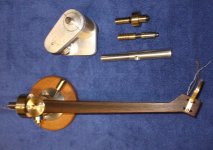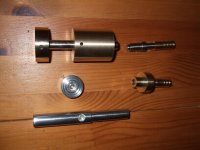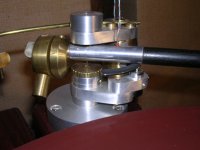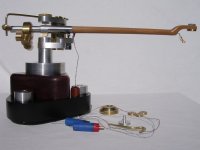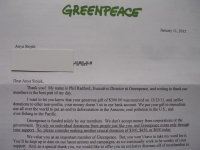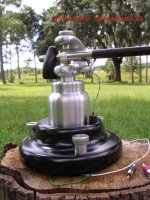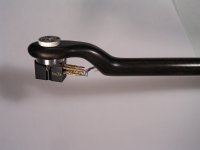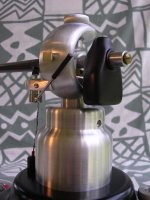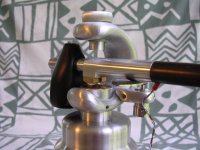marekst said:let us know when you have a working tonearm - details of your struggle are confusing others. There is a parallel thread: "Another DIY Schroeder Tonearm Project" - which I understand is dedicated to excitement of preparations and cyber socializing…
Marek
Sir,
That thread was initiated by Algar Emi and myself. I am in the process of building the arm. I have not posted photos because I am in the middle of the build. Things are moving slowly because I do not have carte blanc access to a machine shop. I can only work on the arm when a gracious family friend allows me access to one of his Bridgeport's. Make no mistake, the build is in progress, albeit slowly. If members wish to utilize our thread for "cyber socializing" until I can get some progress images up, I don't have a problem with that. Neither should you.
I apologize, I was just trying to send you more enthusiastic members.
I have opened second thread about magnetically suspended tonearm, because I wanted to show that it could be done different way - I didn't want to confuse readers of the first thread. I tried to explain the original configuration only after one of Frank's boys emailed me for help.
I thought we search before we open new thread to check if the subject already has an open thread. As you wish, I don't give a .... anymore.
Marek
I have opened second thread about magnetically suspended tonearm, because I wanted to show that it could be done different way - I didn't want to confuse readers of the first thread. I tried to explain the original configuration only after one of Frank's boys emailed me for help.
I thought we search before we open new thread to check if the subject already has an open thread. As you wish, I don't give a .... anymore.
Marek
Bins,
You are confusing my thread with Kilowattski'.
Marek
“This is the message that was sent from velvetsunrise:
***************
Hi, First, let me say, your DIY tonearm looks superb.
I am in the process of building a similar 12inch tonearm, but have hit my first stumbling block, trying to bore a hole down a piece of walnut for the tonearm wand.
Could I ask, did you make those wooden armwands yourself? or do you know of anyone who would be able to make one?
Thanks, kind regards Steve.”
Hi Steve,
I made 2 parallel holes in the ebony wand –read my thread, post #6. If you do not like my method for 12” wand use drill described in post #171 in thread “DIY Schroeder Tonearm???”.
With exception of arm lift and some fasteners I made all parts from raw material at home - I don’t use outside help. I don’t offer any services.
Feel free to ask any questions.
Marek
You are confusing my thread with Kilowattski'.
Marek
“This is the message that was sent from velvetsunrise:
***************
Hi, First, let me say, your DIY tonearm looks superb.
I am in the process of building a similar 12inch tonearm, but have hit my first stumbling block, trying to bore a hole down a piece of walnut for the tonearm wand.
Could I ask, did you make those wooden armwands yourself? or do you know of anyone who would be able to make one?
Thanks, kind regards Steve.”
Hi Steve,
I made 2 parallel holes in the ebony wand –read my thread, post #6. If you do not like my method for 12” wand use drill described in post #171 in thread “DIY Schroeder Tonearm???”.
With exception of arm lift and some fasteners I made all parts from raw material at home - I don’t use outside help. I don’t offer any services.
Feel free to ask any questions.
Marek
magneticly suspended tonearm
Hello.
I have very much enjoyed reading all the threads on this subject, so i have finally started building my own tonearm, but still very early stages.
The base is just about finished, but i am waiting for some M4 CSK non magnetic stainless steel screws to hold the thing together.
I have adapted a 40tpi micrometer thread that i hope to use for VTA adjustment, the upper brass block has a pin, with a keyway in the stainless center bar, allowing the block to rise without rotation when the micrometer thread is turned.
The top thread support is another micrometer thread, this time bored out with a slight taper at the bottom, into this is inserted a tiny downward facing collet arrangement, its purpose to grip the arm supporting thread, the collet is tightend around the thread with an M5 grub screw from the top, hopefully allowing fine tuning of magnet gap via the micrometer thread and also easy thread changeing if required.
Magnets are to be 8mm X 5mm flat discs, though i have reamed the the bottom magnet holder and the armtube magnet recess slightly deeper to allow for the addition of pole pieces if required..
Arm wand will be possibly rosewood, i/2 inch diameter, probably 2 piece as my last attempt a boring a deep hole was a disaster.
I have attached a photo, early days, and unpolished but slowly takeing shape,
Couldnt resist adding a pic of my latest unipivot in there too.
Cheers.
Hello.
I have very much enjoyed reading all the threads on this subject, so i have finally started building my own tonearm, but still very early stages.
The base is just about finished, but i am waiting for some M4 CSK non magnetic stainless steel screws to hold the thing together.
I have adapted a 40tpi micrometer thread that i hope to use for VTA adjustment, the upper brass block has a pin, with a keyway in the stainless center bar, allowing the block to rise without rotation when the micrometer thread is turned.
The top thread support is another micrometer thread, this time bored out with a slight taper at the bottom, into this is inserted a tiny downward facing collet arrangement, its purpose to grip the arm supporting thread, the collet is tightend around the thread with an M5 grub screw from the top, hopefully allowing fine tuning of magnet gap via the micrometer thread and also easy thread changeing if required.
Magnets are to be 8mm X 5mm flat discs, though i have reamed the the bottom magnet holder and the armtube magnet recess slightly deeper to allow for the addition of pole pieces if required..
Arm wand will be possibly rosewood, i/2 inch diameter, probably 2 piece as my last attempt a boring a deep hole was a disaster.
I have attached a photo, early days, and unpolished but slowly takeing shape,
Couldnt resist adding a pic of my latest unipivot in there too.
Cheers.

Attachments
I believe so. As far as I can see you still have at least one rigid coupling to the main structure.I believe that string (with couple kG of tension) conducts some vibrations out
and magnetic field absorbs rest of it (changing it into heat)
Marek
I think the magnetic field will pass most of the vibrations. If you have two magnets with some mutual coupling and one of the two vibrates than it will induce most of it to the other magnet. In particular when the vibration comes from the fixed magnet.
The force that accounts for the mutual interaction is a function of the displacement.
Losses maybe frequency-dependent but are usually small in comparison.
The function of the magnetic field in this tonearm looks a bit like that of the spider in a speaker where it maintains the coil centered but is not vibration free. I can't see a magnetic suspension.
Cheers,
45
45,
I am not sure if I understand your reasoning.
The vibration comes from wand magnet which is not fixed. The vibration is induced in the wand by stylus vibration and we want to drain this vibration energy out of the wand. If the wand moves (vibrates) the wand magnet moves and generates current and heat in the fixed magnet and in the tonearm support. You are right it may also induce some vibration in the tonearm support.
When talking about effectiveness of transfer of vibration energy my bet is on the string not on magnets. I am so convinced that I am ready to sacrifice the “clone” and replace the magnets by a second string tensioned by a spring.
Marek
I am not sure if I understand your reasoning.
The vibration comes from wand magnet which is not fixed. The vibration is induced in the wand by stylus vibration and we want to drain this vibration energy out of the wand. If the wand moves (vibrates) the wand magnet moves and generates current and heat in the fixed magnet and in the tonearm support. You are right it may also induce some vibration in the tonearm support.
When talking about effectiveness of transfer of vibration energy my bet is on the string not on magnets. I am so convinced that I am ready to sacrifice the “clone” and replace the magnets by a second string tensioned by a spring.
Marek
45,
I am not sure if I understand your reasoning.
The vibration comes from wand magnet which is not fixed. The vibration is induced in the wand by stylus vibration and we want to drain this vibration energy out of the wand. If the wand moves (vibrates) the wand magnet moves and generates current and heat in the fixed magnet and in the tonearm support. You are right it may also induce some vibration in the tonearm support.
When talking about effectiveness of transfer of vibration energy my bet is on the string not on magnets. I am so convinced that I am ready to sacrifice the “clone” and replace the magnets by a second string tensioned by a spring.
Marek
The transmission is bilateral. Acoustic feedback from the room also has an effect on both couplings (the magnet and the string). Maybe you are right.
If you add a spring to a second string you will add a new resonance in the audio band. Very unlikely the resonance will be off. I think some listening will be necessary to find the best compromise.
45
The Mutant is gone; I used its parts to make a new tonearm with no magnets in the bearing. I am donating it (all proceeds) to Greenpeace; details are here:
Vinyl Asylum
Vinyl Asylum
The pictures are of my Mutant and what I turned it into. Also, pictures of my best and last tonearm (I’m done with making them). Rebuilt Mutant with no magnets in the bearing was sold for $300 and all proceeds were donated to Greenpeace. Link to thread showing details of my new bearing design below.
http://www.diyaudio.com/forums/analogue-source/157172-diy-tensioned-string-suspended-tonearm.html
I hope it wasn’t my Mutant that “inspired” the Clearaudio to make Verify tonearm.
Marek
http://www.diyaudio.com/forums/analogue-source/157172-diy-tensioned-string-suspended-tonearm.html
I hope it wasn’t my Mutant that “inspired” the Clearaudio to make Verify tonearm.
Marek
Attachments
Thanks dudes,
Gabor, you probably want to make a tonearm close to Schroeder’s, yes? I made it somewhat differently, but if you read my posts it might help you to understand the principle of Schroeder’s magnetic bearing. I like his reference model - its low center of gravity counterweight implies not too stiff a bearing. In my other thread (link above in post #73) is a simplified formula to calculate springing reaction of this kind of bearings.
Good luck with your projects,
Marek
Gabor, you probably want to make a tonearm close to Schroeder’s, yes? I made it somewhat differently, but if you read my posts it might help you to understand the principle of Schroeder’s magnetic bearing. I like his reference model - its low center of gravity counterweight implies not too stiff a bearing. In my other thread (link above in post #73) is a simplified formula to calculate springing reaction of this kind of bearings.
Good luck with your projects,
Marek
Hi Frank,
Thanks for your reply. I am glad that it was not your black magic. Maybe now posts by InDaGroove and others will reappear. It is interesting that only you and two brave Canadians commented on my tonearm. There was one other guy but he only dared to contact me via email.
On technical points you are absolutely right. My arrangement did move the pivot point up (about 1/4”) in relation to record surface. I compensated it a bit by moving the head of the headshell up and lowering the tonearm a bit. I am not going to argue on this mater as I do not know the subject well.
Marek
And now for the benefit of future cloners:
Remember what Frank said about the geometry of the arm. Also, it is much less work to make Franks clone than my mutant.
To drill the magnet, use 1/32” and 1/16” carbide drills from mcmaster.com part No 2841A92 and 2841A94. Drill the hole with 1/16”bit for the knot first. On the opposite side drill 1/16” hole to the depth of about 1/3 of the thickness of the magnet. Finally drill through with the 1/32” bit. This way the fragile 1/32” drill bit will have a shorter distance to go. Be careful when you drill a hole in the screw holding the thread, as brass or aluminum is more likely to break the drill. It takes a few minutes to drill the hole.
Mcmaster.com also has all the metal you will need.
After you tie the knots pull on the thread very hard to test if knots do not slip through the holes. God have mercy on your cart should the thread slip through later on…
For Shelter cartridge I made the wand from ebony wood. After cutting a piece of wood in half length wise, I turned and flipped the top piece to increase stability of the laminate. Before I glued the wood together I made 2 parallel 1/32”deep grooves in each piece from one end to the other. When I put the wood together the grooves formed 2 guiding holes. This way I was able to drill two 1/16” holes trough the wand for left and right channel wires separately. The ebony is very oily so before gluing it together the surface has to be degreased with alcohol. If you opt for drilling one hole for both wires it is possible to use one solid piece of wood as bigger diameter drill won’t drift sideways so much.
For my Shure cart I made ultra light wand out of pernambuco wood drilled with ¼” bit and I filled the inside with balsa wood.
I hope I did not bore you with details, any questions?
I try to built a clone of Schroeder tone arm, bat i failed. The upper magnet did not attract evnly though teh machinery work was precise. The upper string was not in teh center of the hole. I was told that there is a ratio in thickness and diameter between the bottom magnet and the upper one with the string, like if teh bottom one is 5 mm thick the upper should use 2 x 5 mm thickness. Any suggestion for it?
Many thanks.
Adelmo
- Status
- This old topic is closed. If you want to reopen this topic, contact a moderator using the "Report Post" button.
- Home
- Source & Line
- Analogue Source
- Magnetically suspended DIY tonearm
